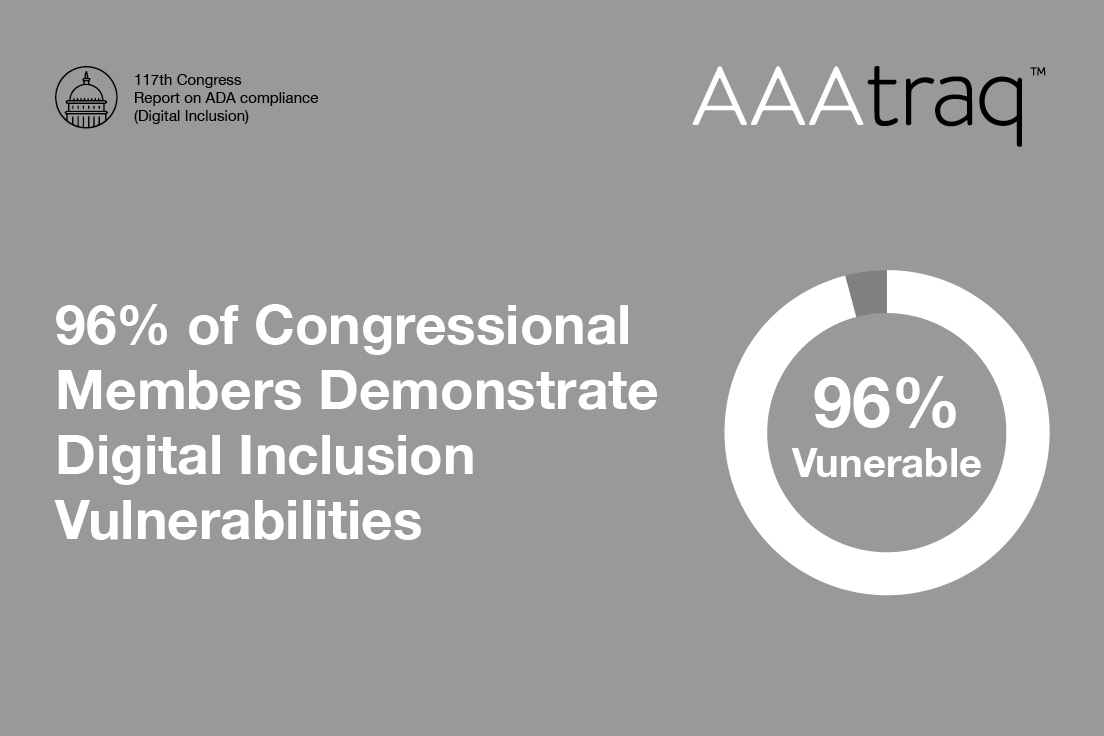Ahead of 2022 Mid-terms, 96% of Congress Discriminates Against Disabled Users
Feb 15 2022
[FEBRUARY 15, 2022 NEW YORK] The latest report by InsurTech company, AAAtraq AAAtraq.com (opens in a new window), evaluated more than 550 websites operated by members and committees of the 117th United States Congress on their websites’ inclusivity.
The report reveals that, over a six-month period of evaluation, the majority of the websites demonstrated little to no meaningful improvement, with 96 out of 100 websites still being vulnerable to litigation. The report additionally presents information on the amount of money now being wasted by organizations on litigation costs – roughly $600,000,000 per month.
Modern society is ever-more dependent on websites. In recent years, accelerated by the COVID-19 pandemic, there has been increased reliance on digital services in government. In this high-profile sector, organizations must start dealing with compliance to the law, such as the Americans with Disabilities Act of 1990 (ADA), to set a positive, non-discriminatory example, whilst avoiding distracting litigation.
The ADA was enacted in 1990, with the intention of eliminating disability-based discrimination. Since its passage, billions of dollars have been spent to make public spaces more accessible to individuals with disabilities. As time passed, the integration of accessibility features into society embedded themselves into the everyday life, with many overlooking just how important such features are to people with disabilities - you wouldn’t expect to find a building without a wheelchair ramp. The law doesn’t just stop at physical spaces. It extends to digital spaces, and websites must adhere to regulations and accommodate people living with disabilities.
In terms of the ADA’s application to websites, a false sense of security within many organizations, leaving owner’s to believe that they have matters in hand. However, as this report demonstrates, the percentage of congressional websites found to be vulnerable, and at risk, exceeds 90%. With this false sense of security, it is no wonder that litigation is growing exponentially.
Part of the problem is the rapid growth of digital; organizations haven’t recognized that their website is a key asset that should be risk-assessed and managed in the same way as any other important asset. Unless organizations appreciate this potential exposure and start to understand the regulatory and societal importance of non-discrimination, opportunist lawyers will continue to ride what has become a very lucrative 'gravy train'.
In evaluating the digital inclusivity of those websites assigned to members of the 117th U.S. Congress, it was found that every website except for three could be evaluated. The websites not being evaluated are due to vacancies in the position at some point during the 6-month evaluation period (meaning there is no direct website to score). Of those able to be scored (in January), approximately 4.09% of members (22 members) fell into the “green” or approaching inclusivity category, with 516 members demonstrating non-compliance. Since the initial report of Congressional Inclusivity Scores in August, 35% of the Representatives and 75% of the Senators who were originally considered to be compliant have fallen out of compliance.
Government organizations need reporting that they can immediately understand, and resolutions should not be left entirely with the technical team. An organization-wide, holistic approach, is required, adhering to basic risk management principles.
Adam Bialek, co-chair of Wilson Elser’s Intellectual Property & Technology practice, said “ADA website cases are one of the fastest growing segments of litigation, up 57% in the last 4 years. Unless website operators become proactive and address accessibility now, it really is a matter of when you will be sued or receive a demand latter, rather than if.”
The findings of the report highlight the level of compliance that Congress is currently achieving and how exposed organizations are to the risk of litigation.
Lawrence Shaw, CEO of AAAtraq commented “Organizations must start thinking about ADA compliance, not just to avoid the risk of litigation and the costs and disruption associated, but also to ensure their meeting their D&I commitments and not discriminating.”
AAAtraq encourages you to take 60 seconds to understand your own risk position – you can do it at AAAtraq.com (opens in a new window) (We don’t ask you to register or promise a report by email – the results are immediately available and understandable. Green = good, red = bad).
For a copy of this report and more information, please contact Andrew Bialek
About Wilson Elser www.wilsonelser.com (opens in a new window)
More than 800 attorneys strong, Wilson Elser is a law firm serving clients of all sizes, across multiple industries and around the world. Wilson Elser has 41 strategically located offices in the United States and another in London. This depth and scale has made us one of the nation’s most influential law firms, ranked in the Am Law 200 and top 53 in the National Law Journal 500.
About AAAtraq AAAtraq.com (opens in a new window)
Websites, like buildings must adhere to the ADA (Americans with Disabilities Act). Despite efforts, the majority are discriminating – resulting in distracting, expensive litigation.
AAAtraq is a CIMS (Compliance Identification and Management System) protecting organizations from ADA litigation.
Our CIMSs’ intelligence engine continuously references 3.6 trillion data-points, comparing actions against known ADA mitigation strategies. Risk managers now have their own monitoring and in the event of failure; severity alerting, claims management, legal support and costs coverage.
Subscribe to AAAtraq and enjoy complete cover and peace of mind
